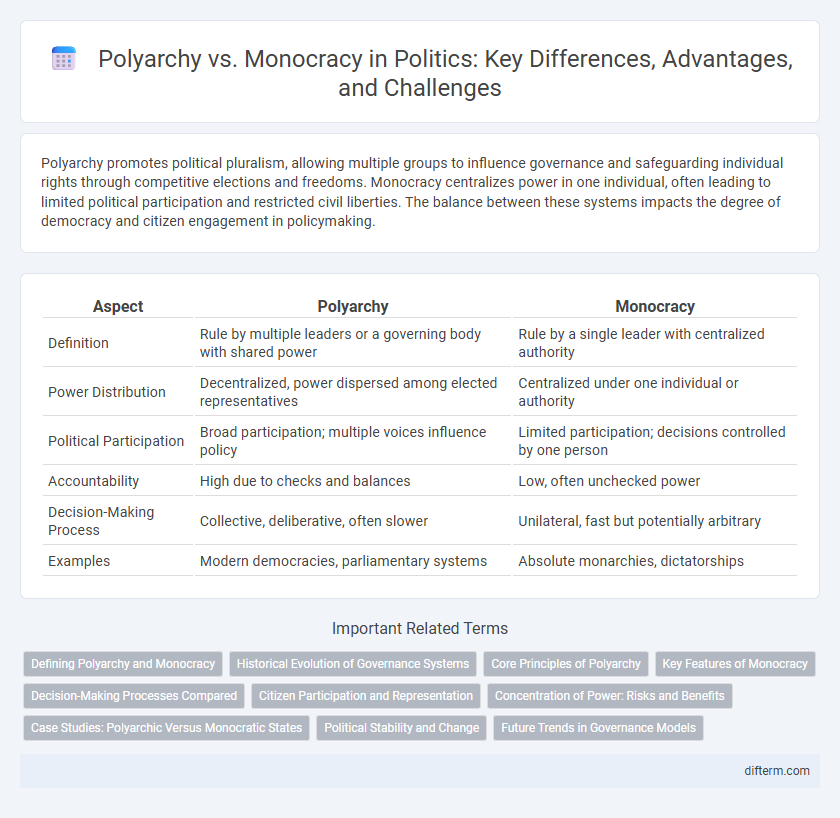Polyarchy promotes political pluralism, allowing multiple groups to influence governance and safeguarding individual rights through competitive elections and freedoms. Monocracy centralizes power in one individual, often leading to limited political participation and restricted civil liberties. The balance between these systems impacts the degree of democracy and citizen engagement in policymaking.
Table of Comparison
| Aspect | Polyarchy | Monocracy |
|---|---|---|
| Definition | Rule by multiple leaders or a governing body with shared power | Rule by a single leader with centralized authority |
| Power Distribution | Decentralized, power dispersed among elected representatives | Centralized under one individual or authority |
| Political Participation | Broad participation; multiple voices influence policy | Limited participation; decisions controlled by one person |
| Accountability | High due to checks and balances | Low, often unchecked power |
| Decision-Making Process | Collective, deliberative, often slower | Unilateral, fast but potentially arbitrary |
| Examples | Modern democracies, parliamentary systems | Absolute monarchies, dictatorships |
Defining Polyarchy and Monocracy
Polyarchy is a form of governance characterized by multiple centers of power, competitive elections, and broad citizen participation, emphasizing pluralism and institutionalized public contestation. Monocracy centralizes authority in a single ruler or group, limiting political competition and concentrating decision-making power without accountability to the general populace. Understanding these distinctions highlights the contrast between inclusive democratic processes and autocratic control in political systems.
Historical Evolution of Governance Systems
Polyarchy, characterized by multiple centers of power and competitive electoral processes, evolved from early democratic practices in ancient Greece and gained prominence during the Enlightenment, emphasizing political pluralism and individual rights. Monocracy, defined by centralized authority vested in a single ruler, dates back to autocratic empires such as Ancient Rome and Imperial China, maintaining dominance through hierarchical structures and limited political participation. The historical evolution of governance systems illustrates a cyclical tension between polyarchic ideals of shared power and monocratic demands for control and order.
Core Principles of Polyarchy
Polyarchy emphasizes pluralism, institutionalized contestation, and broad participation as core principles enabling democratic governance. It advocates for multiple centers of power, free and fair elections, and protection of civil liberties to ensure accountability and responsiveness. These principles distinguish polyarchy from monocracy, where authority is centralized and political competition is restricted.
Key Features of Monocracy
Monocracy centralizes power in the hands of a single ruler who exercises absolute authority without effective checks or balances, often bypassing democratic institutions. Key features include unilateral decision-making, limited political pluralism, and suppression of opposition to maintain control. This system contrasts sharply with polyarchy's inclusive governance, where power is distributed among multiple competing groups.
Decision-Making Processes Compared
Polyarchy emphasizes inclusive decision-making processes where multiple stakeholders participate, ensuring diverse perspectives influence policy outcomes, fostering transparency and accountability. Monocracy centralizes decision authority in a single leader or small elite, often streamlining decisions but risking autocratic rule and limited public input. Comparative studies show polyarchic systems typically promote deliberation and consensus, while monocratic regimes rely on swift, top-down mandates.
Citizen Participation and Representation
Polyarchy fosters extensive citizen participation through competitive elections and institutionalized mechanisms enabling diverse interests to influence policy, contrasting sharply with monocracy where power is concentrated in a single ruler limiting public involvement. In polyarchic systems, elected representatives act as intermediaries translating popular demands into governance, ensuring a broader and more accountable representation. Monocracy often suppresses opposition and controls political expression, thereby diminishing the scope of citizen voice and diminishing democratic legitimacy.
Concentration of Power: Risks and Benefits
Polyarchy distributes political power across multiple actors and institutions, reducing the risk of authoritarian rule and promoting accountability through checks and balances. Monocracy centralizes authority in a single leader or ruling body, which can enable swift decision-making but increases the risk of power abuse and repression. While polyarchic systems foster pluralism and protect civil liberties, monocratic regimes may achieve stability and efficiency at the cost of democratic freedoms.
Case Studies: Polyarchic Versus Monocratic States
Polyarchic states, exemplified by Sweden and Canada, demonstrate robust institutional checks, participatory governance, and protection of civil liberties, fostering sustainable democratic processes. In contrast, monocratic regimes such as Belarus and North Korea centralize power, suppress opposition, and limit political pluralism, leading to authoritarian rule and restricted social freedoms. Comparative case studies reveal that polyarchy promotes political stability and economic development, whereas monocracy often results in political repression and systemic inefficiencies.
Political Stability and Change
Polyarchy fosters political stability through inclusive participation, allowing diverse interests to balance power and enable peaceful transitions. Monocracy consolidates power in a single ruler, often resulting in rapid decision-making but increased risk of instability due to authoritarian backlash or succession crises. Political change in polyarchies tends to be gradual and institutionalized, whereas monocracies face sudden shifts driven by internal power struggles or revolts.
Future Trends in Governance Models
Future trends in governance models indicate a gradual shift from monocracy toward polyarchy as digital technologies and increased political awareness empower pluralistic participation. Emerging platforms for citizen engagement and decentralized decision-making challenge traditional autocratic power structures, promoting transparency and accountability. Data-driven governance and AI-enhanced policy analysis facilitate more responsive, inclusive systems that reflect diverse stakeholder interests.
polyarchy vs monocracy Infographic

 difterm.com
difterm.com